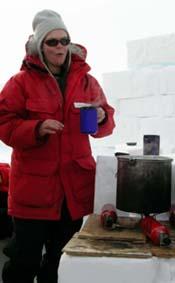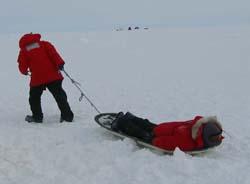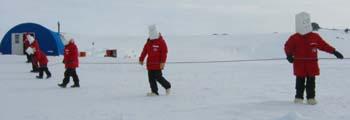19 November, 2003
Happy Campers?
Despite the fact that our Scott tent remained brightly lit throughout
the night, Jackie, Amy, and I slept soundly after our long day of Snow
Craft Class (a.k.a. “Happy Camper School”) yesterday. With three bodies
and all of our gear in the tent, we were quite cozy and we wondered how
our teammates who slept in the quincy and snow trenches fared.
Redressing in the crisp morning air was made easier by the fact that I
had tucked all of my inner layers (long underwear, fleece, socks, and
hat and gloves) into my sleeping bag last night as well as my water
bottles so I would have drinking water in the morning. Having tucked my
bib-overalls and big red parka between my -55º sleeping bag and two
sleeping pads, I was well insulated from the cold ground. My big FDX
snow boots would have been miserably cold had I not slept with the
quilted liners and insoles in the bottom of my bag. But with advance
planning you can be warmly dressed in no time. After a quick hot
breakfast of oatmeal and hot chocolate (Figure 1) we broke down camp and
sledged gear, and in some cases people (Figure 2), back to the storage
facility.
Now that we had shown that we could make it through the night outside we
spent some time at the Instructors’ Hut debriefing about how each person
slept and what people might do differently out in the field. We followed
up this lecture with Radio School where we learned to use the VHF (very
high frequency) handheld radios and the HF (high frequency) systems. The
VHF radios are used for field camps that are within Helicopter range of
McMurdo Station. HF radios are required for deep field camps where
planes are used to drop equipment and personnel. HF radios have long
antennas that allow you to transmit over greater distances by bouncing
the signal off of the atmosphere and back down to a receiver. In this
way, we were able to try to send a message to the South Pole Station
which is approximately 1,000 km from where we were camping.
No class would be complete without a test at the end of each unit. To
pass “Happy Camper School” we needed to demonstrate our proficiency at
basic field survival skills. We were given two scenarios that required
our group to assess a situation and implement the appropriate actions.
Our first scenario involved locating a team member who had walked to the
outhouse during a whiteout and failed to return. Our group was allotted
150 feet of climbing rope as a tool. Armed with our rope, but
“handicapped” by large white buckets on our heads (Figure 3), we headed
out in search of our lost person. The buckets were meant to simulate
white out conditions by depriving us of two senses, sight and hearing.
And they were effective! With your head inside the bucket you could only
see the ground a few inches in front of your toes, which proved to be a
bit dangerous at points as I walked square into the outhouse. In
addition to the very realistic limitation on visibility, it was
extremely difficult to hear your other team members, as it would be with
wind blowing at 30 or 40 miles per hour.
Our team chose to place rescuers at 10 foot intervals along the rope and
then walk out in a single file line in the direction we believed the
bathroom to lie. From that point, we swept the ground in an arc leaving
one man to be the pivot point at the door of the hut (Figure 4). We
found Brian, our victim, with much difficulty on our second sweep of the
camp prompting us to make a rule that from now on, any person using the
bathroom in a white out must tie a rope to his ankle before leaving the
hut to save us the trouble of a rescue! In reality, flagging the route
to the outhouse in the event of bad weather is a sensible plan.
Our second scenario placed us out in the field as the weather was
turning from condition 3 (clear skies and light winds) to condition 1
(severe weather, high winds). Our task was to set up a camp (erect the
tent, build a wind block, set up the stove to boil a quart of water by
melting snow, string the HF radio antenna and successfully place a
test-call to McMurdo Station) all within 30 minutes. We were confident
in our abilities and sure that we had more than sufficient time, until
we discovered that one of our team members, Clive, had wandered off and
laid down on the ground. Clive was hypothermic, a condition where his
core body temperature was falling dangerously low and his mental state
was impaired. He was acting irrationally, trying to take off his coat
despite the fact that he was actually freezing. Susan, our FSTP
instructor for this scenario had instructed Clive to unobstrusively
wander to see if anyone was keeping an eye of the group’s physical
well-being. For this scenario, Clive was in need of medical attention.
He was ushered into a tent out of the wind and made as warm as possible.
Snow was being melted for hot water which would have been important for
Clive to drink as dehydration magnifies the affects of hypothermia. A
call was placed to McMurdo Station informing them of our situation. All
this was accomplished within the 30-minute deadline, but with a much
smaller margin that we had expected. But we had passed the test and our
victim was grateful for our efforts to “save” him.
Having passed “Happy Camper” school we earned ourselves another “Free
Ride” back to McMurdo Station. Once again happily packed into the Delta
we had an opportunity to see part of a Mass Casualty Training Exercise
conducted by the McMurdo Fire Department. They were running a scenario
in which a van had crashed along the road into town. Despite our
newfound confidence with our survival skills we were happy to leave this
scenario to the experts.
As much as we had enjoyed the “Happy Camper School” and wanted to spend
another night in our great shelters and amazing snow kitchen, no one
turned down a hot dinner and showers back at McMurdo. We should sleep
well in our soft, warm beds tonight. We’re one step closer to getting
out into the field, but tomorrow the “Feeding Frenzy” begins.

1. Figure 1 - A quick hot breakfast of oatmeal and hot cocoa hits the spot on a chilly Antarctic morning. --

2. Figure 2 - Sledging gear (and in this case a person) back from our campsite the next morning proved to be a great way to get moving and warm up. --

3. Figure 3 - A "Happy Camper" experiencing a simulated whiteout condition in which we had to search for a lost team member. --

4. Figure 4 - The sweep of the campsite in search of our lost team member proved difficult in our simulated whiteout conditions. --

5. Figure 5 - Leaving a pivot man at the door to the hut allowed the line to fan out across the campsite, as well as ensuring our safe return to the hut. --
Contact the TEA in the field at
.
If you cannot connect through your browser, copy the
TEA's e-mail address in the "To:" line of
your favorite e-mail package.
|
